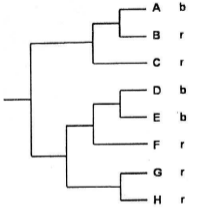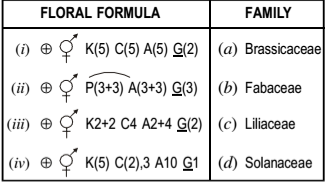 Multiple Choice Questions
Multiple Choice QuestionsWhich of the following groups represents SAR clade of protists?
Euglenozoans, Red algae, Parabasilids
Brown algae, Forams, Radiolarians
Slime moulds, Entamoebas, Diplomonads
Charophyes, Choanoflagellates, Tubulinids
B.
Brown algae, Forams, Radiolarians
Sar or Harosa (informally the SAR supergroup) is a clade that includes stramenopiles (heterokonts), alveolates, and Rhizaria. The first letter of each group provides the “SAR” in the name. The SAR include taxa that are very diverse including some of the most important photosynthetic organisms on Earth. This supergroup can be divided into three clades: the Stramenopiles, the Alveolates and the Rhizaria. Brown Alga is a Stramenopile, while Foram & Radiolarians belong to Rhizaria.
Following table shows a list of clades and plant:
| Clades | Plant |
| (a) Basal angiosperms | (i) Black pepper |
| (b) Magnolids | (ii) Orchid |
| (c) Monocots | (iii) Star anise |
| (d) Eudicots | (iv) Strawberry |
Which one of the following is correct match for the above?
| (a) | (b) | (c) | (d) |
| (iii) | (iv) | (ii) | (i) |
| (a) | (b) | (c) | (d) |
| (i) | (i) | (iii) | (iv |
| (a) | (b) | (c) | (d) |
| (ii) | (iv) | (iii) | (i) |
| (a) | (b) | (c) | (d) |
| (iii) | (i) | (ii) | (iv) |
The phylogenetics tree below shows evolutionary relationships among 8 species. Males of these species are either blue (b) or red (r) in color, the color being indicated next to each species name.

Based on the principle of parismony, which of the following statements best represents the evolution of male body color in this set or species?
The most recent common ancestor of all 8 species was blue; red evolved independently 5 times.
The most recent common ancestor of all 8 species was blue; red evolved independently 4 times.
The most recent common ancestor of all 8 species was red; blue evolved independently 3 times.
The most recent common ancestor of all 8 species was red; blue evolved independently 2 times.
A list of floral formulae and plant families are given in the following table:

Which of the following option most appropriately matches given plant families with their representative floral formulae?
(i)-d, (ii)-(b), (iii)-(a), (iv)-(c)
(i)-(d), (ii)-(c), (iii)-(a), (iv)-(b)
(i)-(d), (ii)-(c), (iii)-(b), (iv)-(a)
(i)-(a), (ii)-(c), (iii)-(b), (iv)-(d)
Which of the following plastid coding region(s) have been recommended as a core barcode by Plant Working Group of the consortium for the Barcode of Life?
CO1 and rbcL
rbcL and matK
CO1 and matK
rbcL only
